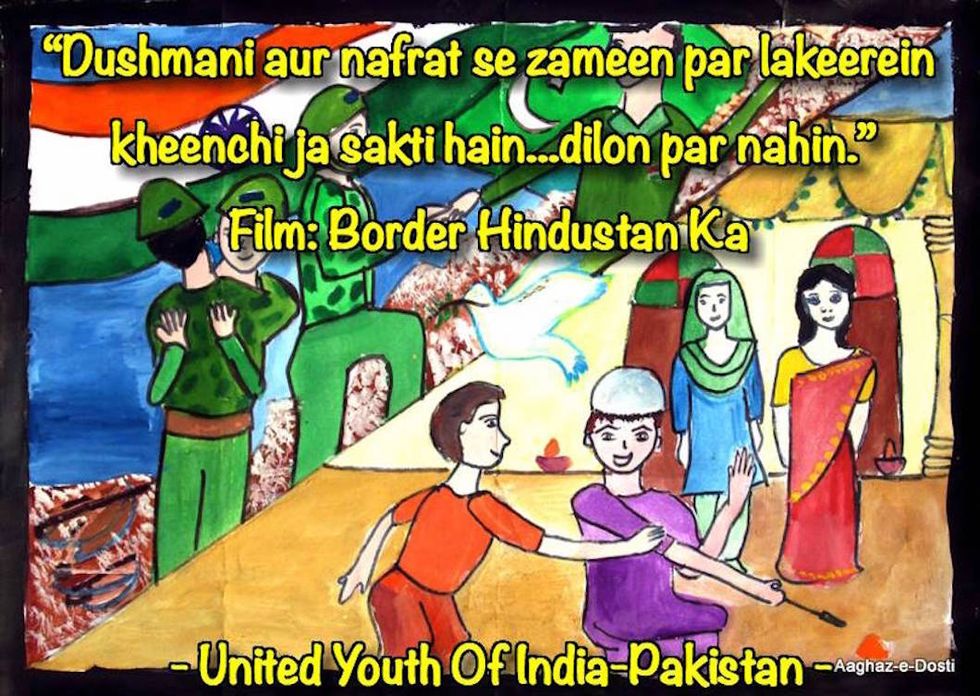The text on the cover image reads:
“Dushmani aur nafrat se zameen par lakeerein kheenchi jaa sakti hain...dilon par nahin.”
Our hearts cannot be divided by hate any longer. We will not allow it. Love will always prevail, and we must encourage it all we can.
In my previous article about activist Sheza Iqbal, we discussed the violent, complex history of India and Pakistan, a history and present tainted by colonialism, corrupt governments, and religious extremism on both sides. Today, I am going to share her thoughts on how to move forward from decades of hate and the violent memory of Partition, and finally secure her goal: peace between India and Pakistan.
Iqbal is the United States based administrator of the wildly popular Facebook group United Youth of India-Pakistan. As someone whose family migrated from India to Pakistan in 1947, and as someone who now spends most of her time in the United States, Iqbal approaches the two nations with a unique perspective. She grew up seeing the similarities between Indians and Pakistanis, as well as their differences; the good and the bad from both sides of a recently created border. This perspective has inspired her goals for the Facebook group, including peace and friendship-based events in neutral territory for Indians and Pakistanis, and in the further future, fighting to ease visa restrictions between the two nations.
When asked about her goals for the group, Iqbal is clearly practiced in explaining her vision. She wants to “bring [back] a pre-Partition harmony that was quite strong. I want to see many Indians and Pakistanis reaching out and seeing the similarities between them.” This may appear simple or common-sense to the average Westerner. Iqbal herself acknowledges that Americans need to “branch out [from a preoccupation with domestic issues]” when it comes to politics around the globe. When considering the history of the nations, and the current political situation between them, the true difficulty of her quest shines through.
Religion has long been used as a tool for violence, dividing those with cultural and spatial similarities. India and Pakistan are no exception. Iqbal finds fault with India for its radical Hindu Nationalism (content warning for violence and mention of rape at the link) and the violence that has come with it. Across the border, Pakistan must begin working harder to combat extremist terrorism from within. She also emphasizes that both sides must do better at condemning senseless violence against religious minorities in the area, like Christians and Shi'ite Muslims.
Iqbal does not want to see religion leave the public sphere entirely, asserting that religion does have a place in society at large. She simply wants to see the removal of the religious extremists in the government and media, who highly influence the average Indian and Pakistani citizen with warped, bigoted views. In discussing this, Iqbal expresses a sentiment felt by members of every nation: “We just need to stop trusting the government [and] the media.” She follows this with another uncomfortably familiar concern: that both sides are more concerned with nationalism than with human rights.
For Indian and Pakistani activists like Iqbal, there is another issue to contend with in their work coming from outside the nations. That is the presence of activists from the United States who want to “help,” but do so in ignorance. Iqbal laments the problems and misconceptions that these activists bring with them: they speak of the India-Pakistan narrative with assumptions of Western superiority and with deep-seated notions of white saviorism.This is compounded, Iqbal notes, by sheer number of educated citizens leaving these nations for the United States, furthering the toxic idea of Western superiority.
To move forward, Iqbal says that activism must be practiced in a cultural context: educating Indians and Pakistanis (especially the youth) on cultural practices and identity is a must. With this will come the natural realization of similarities between two groups of people who should never have been separated. “Our leaders [from both nations] had a better vision for us. Enough is enough; it’s time we did them proud,” she asserts. “We easily fell victim to politics and bigotry, and it’s time to honor [our leaders’] memories.”



















